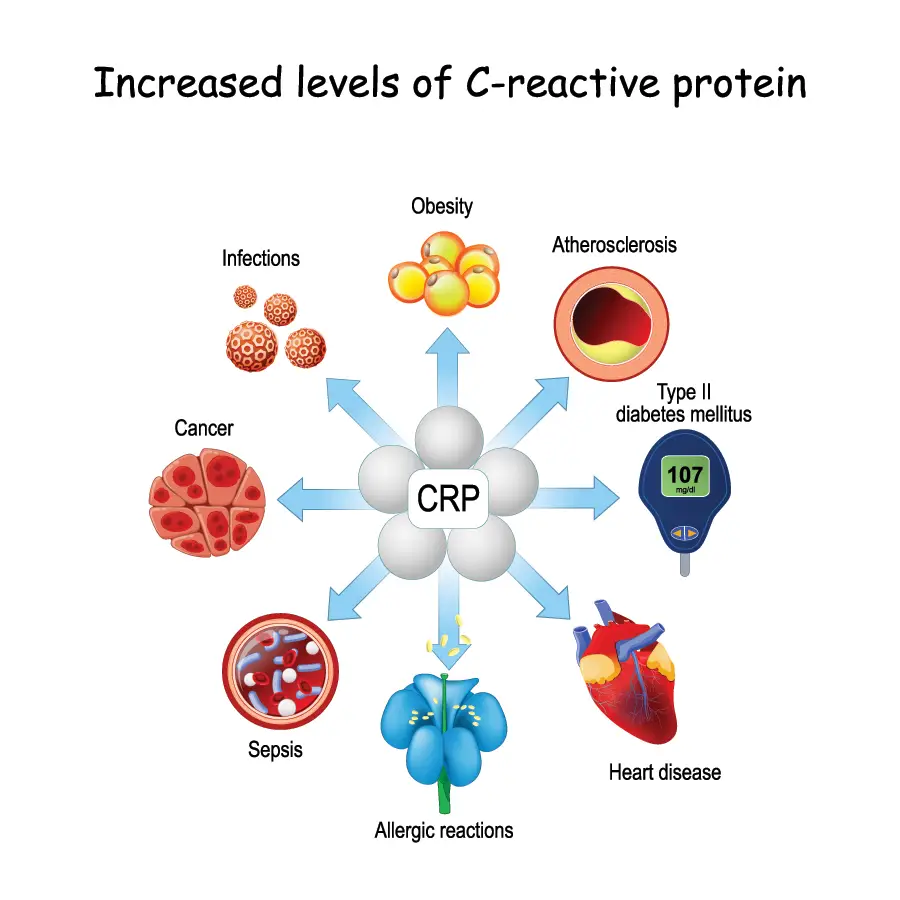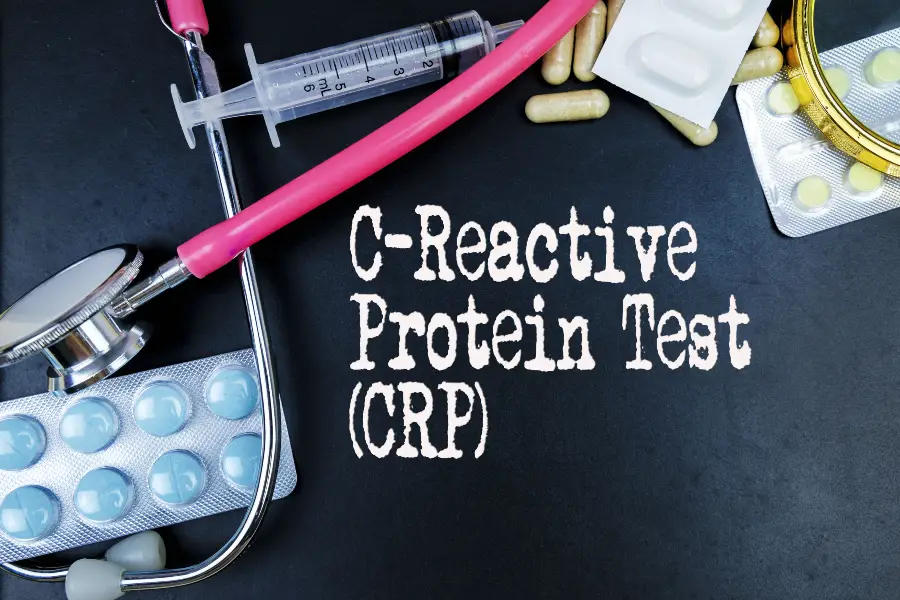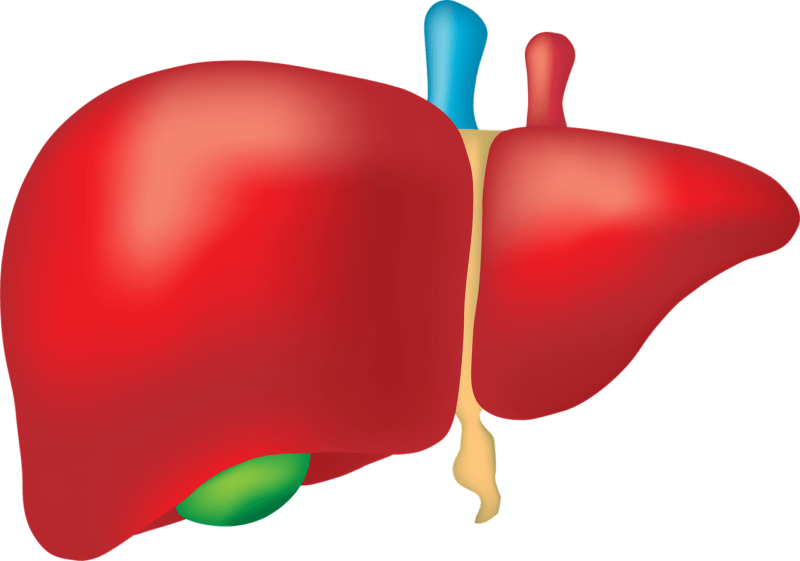Last updated on April 19th, 2022
C-reactive protein is a marker of inflammatory signs in the body. If test results display such numbers, it indicates an ongoing problem in the body. A CRP test assesses blood levels of a substance. This is known as C-reactive protein (CRP). The liver forms CRP responding to inflammation in the body. The body’s healing response is inflammation. When a wound or injury goes red, inflames, or hurts, it represents inflammation. Also, it’s the body’s natural response to illnesses, infections, or trauma.

Inflammatory Processes
The inflammatory process activates a person’s immune system to direct healing WBCs to the infected region. These first respondent cells form chemicals known as cytokines. Cytokines increase the length of the blood vessels. This allows more supply of blood, oxygen, and cells to the region. The enhanced blood flow results in inflammation, heat, and redness.
Inflammation can be of two types: acute and chronic. In acute inflammation, a person’s body reacts to infection or damage. Also, the process persists from hours to numerous days. Yet, in chronic inflammation, the response continues. Also, a person’s body remains in a phase of high vigilance. This low-grade inflammatory process might start harming healthy tissues. And, it results in issues all over the body. Consequently, chronic inflammation is damaging. And, it might add to chronic medical problems like cancer or heart diseases.
When inflammation takes place, the concentration of serum proteins known as acute phase reactants follows inflammation. C reactive protein is one of the acute phase reactants. CRP tests aid doctors detect inflammation. And, the test monitors the efficiency of the current treatment. Inflammation is an intricate, highly arranged method that includes several cell types. These diverse cells might start, augment, maintain, or remove inflammation. Also, they are an indication of heart disorders. Read this article to know what CRP tests are. And, how it helps describe the significance of various CRP levels.


Normal Levels of CRP
The units of CRP measurement are in milligrams of CRP per litre of blood (i.e., mg/L). In healthy people, standard CRP levels must be below 3 mg/L. Even though, reference limits might differ. As an actual fact, the CRP level that is actually normal is unknown. CRP levels more than 3.0 mg/L show start of inflammation in adults. Also, the CRP value usually enhances:
- with age
- in African American people
- in females.
The table below shows what the different CRP levels could indicate. But bear in mind that these ranges may vary slightly between laboratories.
Also Read: Sugar level After Meal
CRP Levels Chart
| Chart of Normal CRP Levels in Adults | ||||
|---|---|---|---|---|
| CRP Level | Elevation | Significance | ||
| Below 3 mg/L | Normal | In healthy adults | ||
| 3-10 mg/L | Normal or minor rise | Because of diabetes, smoking, pregnancy, depression, obesity, inactive lifestyle, or cardiovascular risk | ||
| 10-100 mg/dL | Moderate rise | Autoimmune conditions, heart attack, cancers, bronchitis | ||
| >100 mg/dL | Marked rise | Short-term bacterial or viral infection, or trauma | ||
| >500 mg/dL | Severe rise | Short-term bacterial infections | ||
Summary
C-reactive protein test demands a blood test. The test is generally performed from a vein in the arm. It must not hurt besides a small sting when the needle goes in and leaves the vein. There’s generally no need for preparation like fasting or dodging liquids prior to the test.
How much CRP level is dangerous?
The higher the magnitude of the CRP level higher the prevalence of inflammation. Inflammation in the body is not good for especially for diabetes and heart patioents. CRP level below 3 mg/dL is considered safe and normal. However, a person’s normal CRP level depend son several other factors like age, gender, prevelant disorders, etc. Generally, according to the Rela Hospital website, CRP level between 10 mg/dL to 100 mg/dL depicts moderately dangerous levels of inflammation. Plus, CRP levels anything above 100 mg/dL is severely dangerous. Moreover, this level is of CRP should be avoided especially by diabetes patients and those suffering from heart ailments.
Factors Affecting the CRP levels
Various factors have an effect on C-reactive protein levels, such as:
- Exercise: Strenuous exercise might raise the levels of CRP. As a result, the person must avoid a hard workout prior to giving blood.
- Hormone levels: People utilizing estrogen-based birth control or hormone replacements might experience higher CRP levels. Similarly, pregnancy might increase C-reactive protein levels, chiefly during the later phases.
- Recent infection or injuries: Minor conditions might increase CRP temporarily. According to University of Rochester Medical Center chronic health problems like diabetes or heart disorders increase CRP levels.
- Medicines: According to Rochester University Medical Center, few cholesterol-reducing medicines (statins), and NSAIDs, might lower your inflammation and reduce CRP levels.
- Magnesium supplementation: This might reduce CRP levels in a few individuals. Ask the doctor whether to stop the use of supplements before drawing blood.
- Other factors: People might have higher baseline CRP levels. These may include females, elders, smokers, diabetics, people with obesity, or depression.
Also Read: Coconut water for diabetes
When a Healthcare Provider Orders a CRP Test
Doctor might order a CRP test if a person has signs of a severe bacterial or viral infection like:
- nausea and vomiting
- fast breathing
- fever or chills
- abnormal heart rate
The doctor might also order a CRP test to monitor the ongoing treatment if a person has a diagnosis of chronic autoimmune conditions like lupus. It monitors the level of the latest inflammation. If treatment is functional, inflammation and CRP levels fall down.
As doctors cannot always draw solid outcomes from CRP levels alone, they might also request other tests. They offer a higher thorough overview of a person’s health. CRP may also work as a predictor of CHF. If a person is at risk of heart disorder, the doctor might also request a high-sensitivity CRP test. The high sensitivity CRP test is a special test that identifies lower levels of CRP in the blood as compared to the routine test results. The high sensitivity CRP level ranges from 0.5 to 10 mg/L. Levels more than 3 mg/L are high risk for developing heart problems.
Summary
Classically, CRP tests are rapid and precise. Yet, if a person has only slightly raised CRP levels, the test may be hard to interpret. This can be due to several potential conditions responsible for this effect. High CRP is a biomarker. That means that it’s one factor to contemplate while evaluating a person’s health. Also, it does not deliver a source of inflammation. A high CRP level is not a separate diagnosis.
What is Taken as a High CRP Level?
According to the Mayo Clinic, CPR Levels more than 8 mg/dL, is taken as a high CRP level. Usually, “a CRP reading above 10 mg/L is risky. It potentially results due to a serious bacterial infection. Also, it shows short-term inflammation demanding additional tests to detect the cause of the inflammation.
Signs of high CRP
The signs of high CRP levels are based upon underlying problems responsible for inflammation. It’s likely to experience high C-Reactive protein levels with no signs. If a person experiences a moderate infection or injury that results in inflammation- According to Rochester University’s Health Center signs can be:
- unexplained weight loss
- low-grade fever
- bloating
- headaches
- general weakness
- pain all over the body
- fatigue
- chills
- GI troubles like nausea, loss of hunger, or indigestion
- difficulty sleeping or insomnia
Also Read: Is jaggery good for diabetes?
Reasons for High C-reactive Protein Levels
High CRP levels may take place due to:
- Obesity
- Smoking
- Severe bacterial or fungal infections
- Pneumonia
- UTIs
- Bronchitis
- Viral problems such as COVID-19
- Pregnancy
- Depression
- Diabetes
- Sepsis
- Osteomyelitis
- Heart attack
- Cancer
- Inactive lifestyle
- Lupus, rheumatoid arthritis
CRP Levels and COVID-19
C-Reactive protein levels seem to enhance in individuals affected with SARS-CoV-2. It is a virus responsible for COVID-19. Serious COVID-19 infections may result in an overproduction of inflammatory cytokines and interleukins. According to a 2021 report by International Journal of Epidemiology says, CRP messengers assist the body in fighting the virus. Also, they may harm lung tissue when the immune system over-responds. In combination, the inflammatory cytokines and tissue damage may enhance the production of CRP.
Also Read: Best glucometer in India
Reducing CRP Levels
There’s an array of dietary approaches and lifestyle changes to reduce C-reactive protein levels. Moreover, a doctor might suggest medicine if suitable.
Treat the underlying health problem
The most significant step a person must take is to discuss with a doctor to identify why it is raised. Treating the condition responsible for inflammation is vital for lowering a raised CRP level.
Weight loss
Weight loss helps to lessen CRP levels.
Exercise
Increasing the heart rate and regular physical activity lowers down CRP levels due to an inactive lifestyle. And, the amount of exercise required to reduce CRP levels isn’t much. The total energy expenditure of approximately 1,000 calories per week may help.
Mindset
Mental outlook has an effect on the body and C-reactive protein levels. Mindfulness practices, meditation, and yoga helps to change a person’s mental outlook.
Diet
To aid the reduction of systemic inflammation and CRP levels, a person must have a multi-coloured diet. The diet must be rich in fibre, fruits and veggies. A Mediterranean-style diet is a superb choice. Good foods to add-in can be:
- bananas
- pears
- beans and legumes
- apples
- avocados
- whole grains
- cruciferous veggies such as brussels sprouts and broccoli
- strawberries
Intake of a small amount of alcohol, like a glass of wine, helps to reduce C-Reactive protein levels more so than avoiding alcohol altogether. The kind of alcohol seems irrelevant, as long it’s within limits (not above 7 alcoholic drinks a week for females or 14 for men). Other valuable drinks to consider can be coffee and green tea. It appears that a greater intake of coffee and lower CRP accompanies each other. The compounds present in green tea lower the markers of inflammation, like CRP.
Supplements
“Supplements may also lower C-reactive protein levels,” says a 2021 study by National Library of Medicine. Omega-3 fatty acids can reduce inflammation according to the American Heart Association. Additionally, some research shows that vitamin D can reduce inflammation, and C-Reactive protein levels.
Summary
Doctors make use of CRP tests to identify the levels of CRP in the body. A rise in the levels of protein might show an underlying health problem. The treatment for raised levels varies as per the cause. A range of health problems may result in mildly or moderately increased levels. Also, very high C-Reactive protein levels are usually simpler to detect.
FAQs:
What ailments result in high CRP?
Does level of CRP rise in viral infection?
How rapidly does CRP reduce?
What level of CRP shows COVID?
Last Updated on by Dr. Damanjit Duggal
Disclaimer
This site provides educational content; however, it is not a substitute for professional medical guidance. Readers should consult their healthcare professional for personalised guidance. We work hard to provide accurate and helpful information. Your well-being is important to us, and we value your feedback. To learn more, visit our editorial policy page for details on our content guidelines and the content creation process.

 English
English














